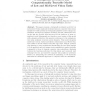Free Online Productivity Tools
i2Speak
i2Symbol
i2OCR
iTex2Img
iWeb2Print
iWeb2Shot
i2Type
iPdf2Split
iPdf2Merge
i2Bopomofo
i2Arabic
i2Style
i2Image
i2PDF
iLatex2Rtf
Sci2ools
ECCV
2004
Springer
2004
Springer
A Biologically Motivated and Computationally Tractable Model of Low and Mid-Level Vision Tasks
This paper presents a biologically motivated model for low and mid-level vision tasks and its interpretation in computer vision terms. Initially we briefly present the biologically plausible model of image segmentation developed by Stephen Grossberg and his collaborators during the last two decades, that has served as the backbone of many researchers' work. Subsequently we describe a novel version of this model with a simpler architecture but superior performance to the original system using nonlinear recurrent neural dynamics. This model integrates multi-scale contour, surface and saliency information in an efficient way, and results in smooth surfaces and thin edge maps, without posterior edge thinning or some sophisticated thresholding process. When applied to both synthetic and true images it gives satisfactory results, favorably comparable to those of classical computer vision algorithms. Analogies between the functions performed by this system and commonly used techniques fo...
Computer Vision | ECCV 2004 | Mid-level Vision Tasks | Recurrent Neural Dynamics | Sophisticated Thresholding Process | Vision Algorithms | Vision Terms |
| Added | 15 Oct 2009 |
| Updated | 15 Oct 2009 |
| Type | Conference |
| Year | 2004 |
| Where | ECCV |
| Authors | Iasonas Kokkinos, Rachid Deriche, Petros Maragos, Olivier D. Faugeras |
Comments (0)

